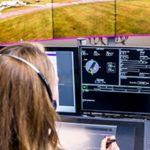LIFT Aircraft has developed an electric, vertical take-off and landing (eVTOL) aircraft. The company plans to open LIFT locations where anyone will be able to rent aircraft without a pilot’s licence.
LIFT is launching what it calls “the world’s first experiential entertainment business leveraging eVTOL aircraft”. The company plans to own and operate fleets of aircraft in scenic and uncongested areas near major metro areas, tourist destinations and entertainment hubs.
LIFT is launching what it calls “the world’s first experiential entertainment business leveraging eVTOL aircraft”.
After training in LIFT’s virtual reality simulators, anyone (over the age of 18, and up to 6’ 5” tall and 250 lbs) will be able to fly for up to 15 minutes at a time.
Consumerising flight
Matt Chasen, founder & CEO of LIFT, said: “Flying is probably the oldest and most enduring of human aspirations. Personal aviation is available today but it’s only accessible to the lucky few with the money, time and skill to get the extensive training needed to fly traditional aircraft. At LIFT, we’re making flying so simple, safe and inexpensive that anyone can do it with very little skill or special training. We’re truly consumerising flying for the first time in history.”
“At LIFT, we’re making flying so simple, safe and inexpensive that anyone can do it with very little skill or special training. We’re truly consumerising flying for the first time in history.”
Chasen is a serial entrepreneur and investor – in 2003, he founded uShip, an online marketplace for shipping. He also worked as an engineer at Boeing in Seattle. Prior to this, he studied mechanical and aerospace engineering and was a NASA scholarship recipient.
The LIFT aircraft, named Hexa, resembles a large drone with 18 sets of propellers, motors and batteries. It has one seat for the pilot and weighs only 432 lbs – which qualifies it as a Powered Ultralight by the FAA, which is why no pilot’s licence is required to fly.
Propulsion
The aircraft uses distributed electric propulsion (DEP), which allows an aircraft to be controlled by varying the speed of multiple electric motors through flight control computers.
Colin Guinn, a drone expert who has held leadership roles at DJI, 3D Robotics and Hangar Technologies, said: “The pilot is not flying the aircraft in the sense of traditional helicopters and fixed-wing airplanes. With DEP aircraft, like with drones, the flight computer is keeping the aircraft stabilised and the pilot merely provides control inputs using a joystick”
Chasen added: “The vast majority of accidents are the result of pilot error – running out of fuel, controlled flight into terrain, flying in bad weather, etc. Hexa is semi-autonomous so, regardless of what the pilot does, it will only fly in a safe manner within the limits programmed into the autopilot computer.
“Autonomy is actually much easier in the air than for cars on the ground – there are far fewer obstacles, no roads, no traffic lights, and you have three dimensions to move around. For example, the aircraft is continuously calculating the energy required to ‘return to home’ based altitude, wind speed and direction. Regardless of what the pilot does, the aircraft will automatically return and land when the battery approaches this level plus a reserve, and it can also automatically land in designated safe landing areas, if necessary.”
Hexa can fly with up to six of its eighteen motors out. It has a ballistic parachute that automatically deploys in the event of an emergency. It also comes with five floats to land on water, and can be controlled remotely by LIFT safety pilots in the event of an emergency.
“LIFT’s safety will come not just from the simplicity and redundancy of the design, but also from the fact that flights will take place in very controlled environments.”
Charlie Justiz, the former Chief of Aviation Safety at NASA, said: “LIFT’s safety will come not just from the simplicity and redundancy of the design, but also from the fact that flights will take place in very controlled environments – 3D mapped areas where on-board sensors and ground-based radars can track every aircraft and obstruction… and flights will only take place in good weather conditions.”
Demand
Chasen said: “Leveraging ultralight eVTOL aircraft for recreational flying is a necessary step for the nascent eVTOL industry before it’s ready for commercial transportation.”
LIFT has opened a waitlist for flights in 25 cities. It will open up locations based on where it gets the most demand.

